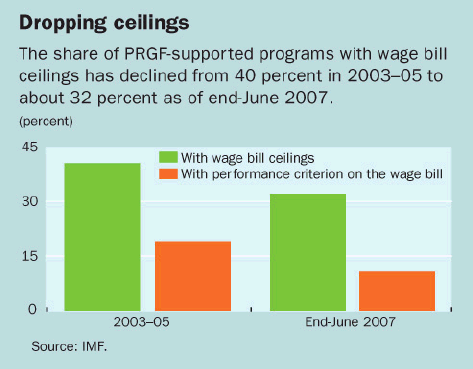
Typical street scene in Santa Ana, El Salvador. (Photo: iStock)
IMF Survey: IMF Trims Use of Wage Bill Ceilings
September 5, 2007
- MDGs call for much higher government spending on human resources
- IMF revisits use of public sector wage bill ceilings
- New guidelines call for more flexibility to accommodate scaled-up aid
A subject of substantial controversy over the past few years has been the use of wage bill ceilings in policy programs supported by the IMF's Poverty Reduction and Growth Facility (PRGF).

School in Maputo, Mozambique—where wage bill caps allowed extra hires in priority sectors such as education (photo: Jerome Delay/AFP)
IMF AND LOW-INCOME COUNTRIES
Many critics claim that caps on public sector wage bills have stopped low-income countries from using donor resources for expanding employment in key poverty-reducing sectors, like health and education. This, they argue, has hurt the quality—and hindered the expansion—of service delivery, be it in combating HIV/AIDS or increasing primary school enrollment, and, in turn, has impeded their progress towards the Millennium Development Goals (MDGs).
Under scrutiny from critics, as well as its own official watchdog (the Independent Evaluation Office), the IMF has recently reexamined the use of wage bill ceilings as part of a larger review of its advice to low-income member countries in the face of high and volatile aid inflows. The new guidelines call for transparent and sufficiently flexible ceilings that can accommodate spending of scaled-up aid, particularly for sustainable donor-financed employment in the social sectors.
Rationale for caps on wage bills
If countries are to meet the MDGs, governments will indeed need to spend more to address their human resource constraints. In some cases, however, already high wage bills can hinder governments from doing so without complicating macroeconomic management. As a result, many countries have responded by establishing wage bill ceilings in the context of a PRGF-supported program as a complement to other fiscal targets in an effort to keep wage costs in check, while attempting to protect spending, including for additional hiring, in priority sectors.
Wage bill ceilings usually provide only a short-term fix and ultimately need to be supplanted by civil service reform. Prolonged use of wage bill ceilings may lock in inappropriate civil service structures unless combined with structural reforms to address inefficiencies of civil service employment and pay structures.
Often, civil service reform is needed to address problems such as overly compressed wage scales; overstaffing (particularly, at lower levels of government); and ineffective promotion, transfer, hiring, and redundancy procedures. In addition, wage ceilings may create incentives to increase nonwage compensation, such as housing allowances and other in-kind benefits. In these cases, the resulting fragmentation of civil servant remuneration can encourage inequities in compensation, reduce the overall transparency of such spending and, hence, render wage bill ceilings ineffective.
Wage bill ceilings in practice
To what extent have wage bill ceilings been included in PRGF-supported programs? They have been applied only when first-best measures to control wage costs—such as the introduction of functioning payroll systems or strong budget controls—have not been available, and the share of PRGF-supported programs with wage bill ceilings has declined from 40 percent in 2003-05 to about 32 percent as of end-June 2007 (see chart).

Only three out of a total of 28 PRGF arrangements—those for the Central African Republic, Chad, and Malawi—had wage ceilings as a quantitative performance criterion (a measure that is so critical, by itself, that non-implementation would warrant considering the program to be off track); another six programs include them as indicative targets (a weaker form of conditionality).
Applying the ceiling
In general, wage bill ceilings have been used to address concerns about wage bill dynamics and to support structural reforms of public sector employment and wages.
In Ghana, where wage spending had been a source of significant budget overruns, the government's PRGF-supported program included a performance criterion on the wage bill in 2005. The ceiling was established to support government efforts to bring wages under control, while a computerized payroll system for the public sector was being developed. The PRGF-supported program with Ghana was concluded in October 2006.
In Mozambique, similar concerns about a loss of fiscal control as a result of a ballooning wage bill led the government to introduce a quantitative benchmark on the wage bill in its PRGF-supported program in 2004. The benchmark aimed at focusing attention on factors underlying wage increases, and highlighted the need to link civil service hiring decisions to overall development objectives and comprehensive civil service reform. It also served to stress concerns about potential macroeconomic problems that could result from entering into long-term expenditure commitments without long-term donor commitments to finance them. Meanwhile, Mozambique has successfully moved beyond the post-conflict environment under which the ceilings were initially established, and the wage bill conditionality was dropped in June 2006.
Nicaragua agreed to the introduction of a performance criterion on the wage bill against a background of public sector wages being well above comparable private sector wages, while the wage bill had grown rapidly to reach about 8½ percent of GDP at end-2005, at the high end for Latin American countries. The performance criterion reflected concerns about the risk of a wage-price spiral that could undermine the country's external competitiveness. The PRGF-supported program with Nicaragua was concluded in December 2006.
What has been their impact? A recent review by Fund staff found that despite their intended short-term nature, wage bill ceilings tended to persist in PRGF-supported programs, were difficult to monitor, and distracted governments from efforts to strengthen institutions for better controlling wage spending. But the review also concluded that wage bill ceilings were never applied to a specific sector, and indeed in some cases, priority sectors—such as education—were excluded from the wage bill ceiling (for example, in Benin).
The ceilings also allowed flexibility to expand employment in priority sectors when external financing was available (for example, in Senegal, Malawi, and Zambia). In addition, periodic program reviews provided opportunities for adjusting these ceilings as resource availability and priorities changed.
A recent report by the Center for Global Development (CGD) also looks at the use of wage bill ceilings in PRGF-supported programs. In the case of Zambia, it found that their initial application was justified as a short-term instrument to rein in payroll dynamics that threatened macroeconomic stability. In the case of Mozambique, these ceilings were included in programs because of large increases in the wage bill, apparently only in part aimed at priority sectors. In practice, however, the ceilings were relatively lax, and hence apparently did not impose a major constraint on the wage bill.
In both cases, additional recruitment was allowed in priority sectors (mostly health and education), although wage bill ceilings were found to be ineffective in protecting priority spending, partly because there was no way to enforce or systematically monitor whether such priority uses under the ceilings were implemented.
The way forward
As countries strengthen their budget and payroll systems and formulate fiscal policy using medium-term frameworks, the need for wage bill ceilings as a means for controlling wage and employment costs will diminish. However, developing these systems will take time. In the interim, there may be an occasional need for wage bill ceilings, and after much dialogue and debate, the IMF has recently clarified policies regarding the use of such ceilings in PRGF-supported programs, underscoring that they will be used in exceptional circumstances and should be based on the following criteria:
• Clear justification. The rationale for wage bill ceilings should be guided by macroeconomic considerations. Program documentation should justify their use in a transparent manner, including their consistency with the MDGs.
• Limited duration. Wage bill ceilings are a temporary device. Governments should tackle the root causes of wage-related fiscal problems, such as the need for civil service reform and strengthened payroll management.
• Sufficient flexibility. Wage bill ceilings should be sufficiently flexible to accommodate spending of scaled-up aid, particularly for sustainable donor-financed employment in priority sectors such as education and health.
• Periodic reassessments. The need and rationale for wage bill ceilings should be reassessed at the time of program reviews.
This article is the latest in a series on the IMF's role in low-income countries and follows "IMF moves to clarify aid role."


